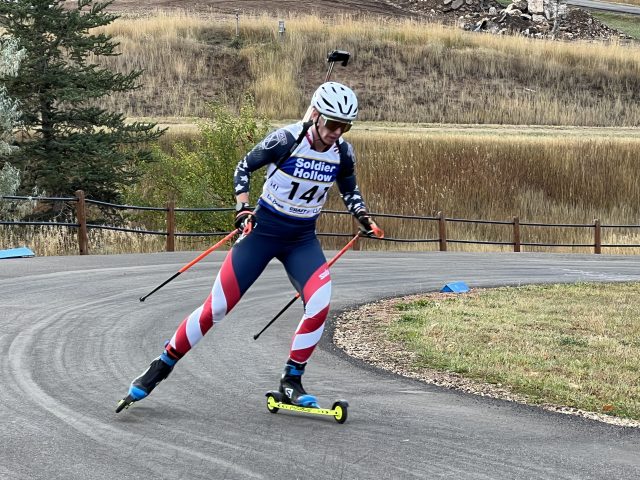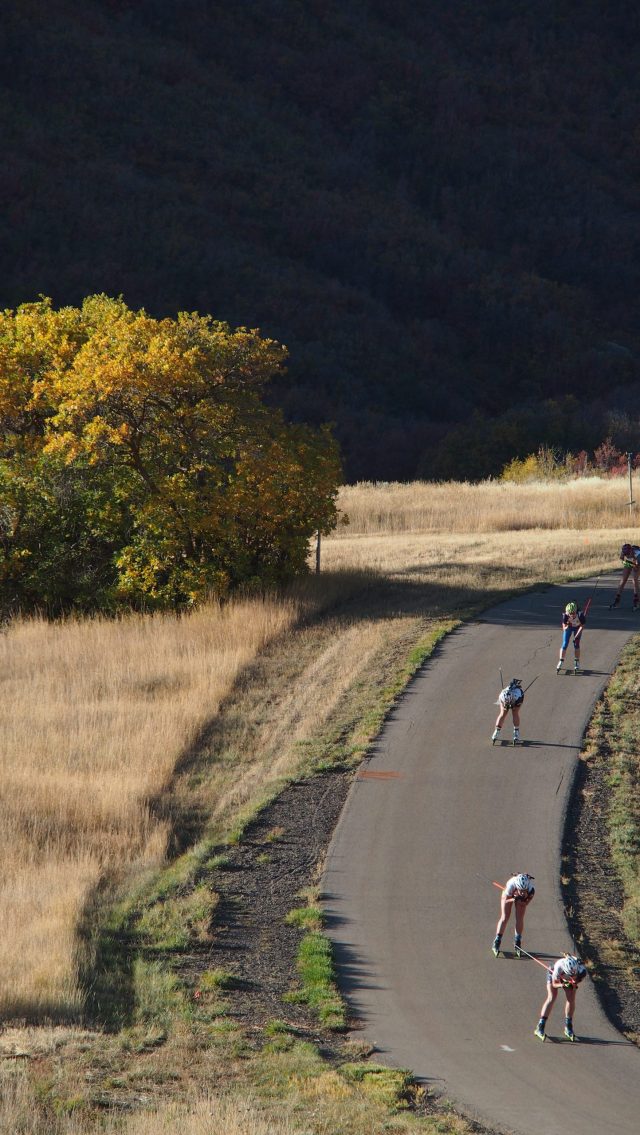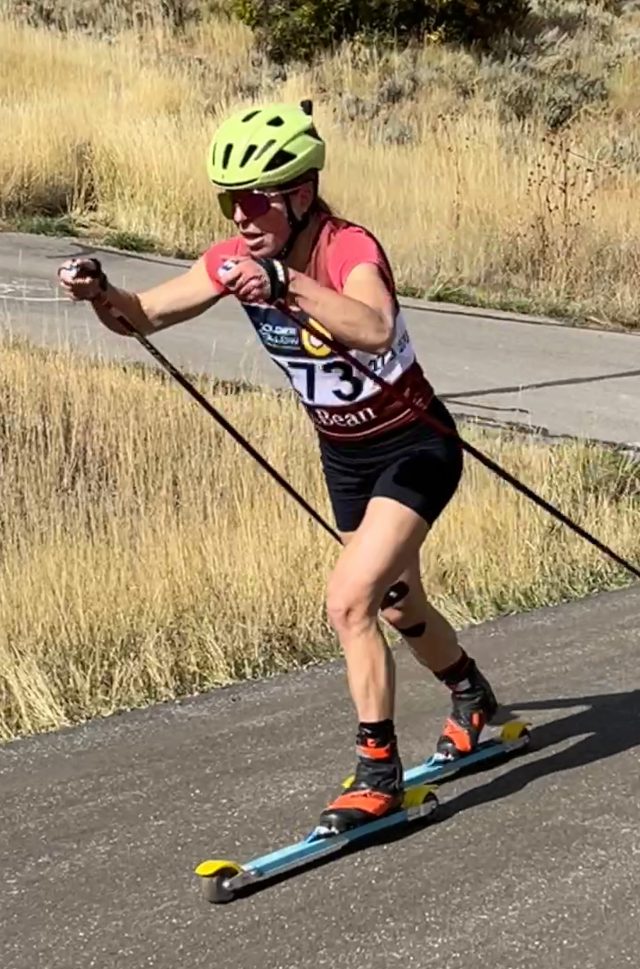
On a sunny October Saturday, the Path of the Annularity—the shadow of an eclipse—passed directly over Soldier Hollow, Utah. For nearly thirty minutes, the sky was shaded, the air cooled, and the valley got eerily quiet. But the action never stopped: races went on, heart rates remained high, sweat continued to drip, and finish lines were crossed while the solar/lunar show swirled in the heavens above. Something special was happening, that’s for sure . . .
Now in its third year, the Schutzenski Festival—hosted by Soldier Hollow Nordic Center in Midway, Utah—is offering a blueprint of what rollerski festivals may look like in years to come. In a weekend that included ski events, biathlon events, team selections, and top-tier competition, the potential for development appears limitless. And how ironic that the popular future of biathlon and Nordic skiing may be demonstrated here on an ashpalt-ribbon race course where athletes compete on wheels rather than skis.

This season’s Schutzenski highlights included astounding performances from USBA standout, Deedra Irwin—winner of both days’ events due to her fast skiing and near-perfect shooting. She shared the spotlight with up-and-coming American men—especially Campbell Wright and Maxime Germain—who showed that American biathlon has a bright future on the international stage.

Outstanding Nordic performances were also delivered by US Nordic skiers. Rosie Brennan strided to victory in the 10k Classic event ahead of Jessie Diggins. Diggins also finished second behind Julia Kern in Saturday’s Sprint competition. Gus Schumacher narrowly bested Ben Ogden in the 10k, while Ogden recovered to win the Sprints on the following day.

Racing and Qualifying
The trails at Soldier Hollow were designed and built for Biathlon and Nordic events staged during the Salt Lake City Olympic Winter Games of 2002. But the work on these facilities did not stop after the Olympics. Ever since, Soldier Hollow has continued to develop trails and programs as one of the premier Nordic/Biathlon facilities in the world. The world continues to take notice: Olympic and FIS World Cup Champion, Johannes Hoesflot Klaebo (NOR), now makes Soldier Hollow a regular training camp venue in his summer program. Likewise, the Stifel U.S. Cross Country Ski Team hosts a series of camps in Park City and Soldier Hollow, including the National Elite Group (NEG) Camp that coincided with Schutzenski 2023. And U.S. Biathlon (USBA) has fully invested in the facility with a new USBA Headquarters currently under construction in the center of the SoHo trail network. That facility—USBA’s new permanent home—is slated to be completed in time for next spring’s Biathlon World Cup, hosted March 8-10 at Soldier Hollow.
USBA used these Schutzenski races as the sole qualifying procedure for the European Camp that precedes the IBU World Cup season opener in Kontiolahti, Finland. The top nine qualifiers (based on Schutzenski event results) will travel with the US Team to Finland for a pre-World Cup camp. Individual performances in test events staged during that camp will determine start positions for this first IBU World Cup weekend.
John Farra—USBA’s Director of Sport Development, and Member of the IBU Development Commission—commented on the scheduling and the process:
“Obviously, we don’t want to wait until November—the [World Cup] trip leaves in two weeks . . . So, this year, the new move is that the top nine qualifiers go to Finland. Everybody’s together, we have a training camp, we have a time trial. And that selects who gets to go to the first World Cup in Kontiolahti. Hopefully we get the top nine right. That’s our new try, and people are excited about it.”
Farra also commented on the discrepancies that may exist between rollerskiing and skiing on snow, and explained the USBA’s decision to utilize these races as legitimate qualifying events:
“Roller skis are different from snow, right? The movement on skis, the technique, the downhill on an icy corner: it’s just different. We’re trying to make a selection that’s fair to everyone, and takes a group of great athletes to snow, and to a venue where we can fairly make final selections. Let’s get everybody over there, everybody’s fair and square, you all get to go to Finland, you all get to be at training camp, and then we’ll all have a time trial ten days before the first race. Then we determine who’s going to be in this race versus that race.

“In the end, our sport is about fitness,” Farra said. “It’s about an engine, and having the ability to just bury yourself, physically. So do believe, in the end, that these races are as good a test as we can make them.”
This new team qualification strategy not only allows contenders to prove themselves on snow, but also speaks of the growing emphasis on roller skiing as a means of predicting an athlete’s on-snow potential. The technique comparisons between roller skiing and on-snow skiing are imperfect—classic kick is certainly a simpler, less subtle movement on roller skis than on snow—with poling, kick, edging, glide, balance becoming motions that are determined more by the equipment and the ski-surface than by the athlete and their particular technical nuances.

Wheels or Skis? Asphalt or Snow?
Over the past twenty years, ski-training has gravitated more and more toward the predominance of roller skiing. Twenty years ago, Nordic training programs still included a great deal of cycling, running, bounding, hiking. While those activities still exist to occasionally flavor the training regimens of elite skiers, those athletes are now (for the most part) year-round skiers: on snow in winter and spring; on wheels in summer and fall. Coaches no longer seem to fear technique glitches and habits that may develop during the roller ski season; it all seems to be worth it for the specific stress and nearly-perfect muscle training that roller skiing offers. The best skiers now seem determined to ski year-round. Access to refrigerated snow tunnels in Europe—or to snowfields in the southern hemisphere—has ultimately proven impractical (and sometimes unhealthy with the social crowdedness of “camp” settings). Rather than traveling the world chasing snow, many ski athletes—especially North Americans—have definitely come to rely almost exclusively on the smoothly paved roads in and around their home bases. And nowhere in North America offers better facilities for that sort of training than Soldier Hollow.
Rollerskiing is developing into a sport discipline of its own, with ski athletes, rollerski athletes, and skiing fans now enjoying a FIS World Cup in rollerskiing. The record of transitions of high-profile athletes from other “roller sports” into gliding sports offers considerable proof of the abilities of athletes to adapt from one technique to the other. Especially in the United States, roller skating stars have been invading ice speedskating for years. There is no roller skating in the Summer Olympics, so American roller skaters began making the transition to ice. The techniques of the two sports—though appearing nearly identical—are actually quite different down where the rubber meets the road or the blade meets the ice. Coaches and competitors did not predict much success for them. Well, the ice speedskaters were forced to eat their words in the wake of the World Championship and Olympic successes achieved by athletes like Derek Parra, Chad Hedrick, Brittany Bowe, and Erin Jackson. The best roller skating athletes proved to be the best skating athletes, period. Watch for similar developments as the world of rollerskiing (especially at the FIS World Cup level) begins to produce athletes who are eager for the challenges of FIS cross country events.

Festivals and Races
High-profile rollerski festivals—like the internationally promoted Blink Festival in Sandnes, Norway—typically offer both Biathlon and Nordic events. Such festivals have gained enormous popularity among fans in Europe, Russia, and Scandinavia. Some notable American Nordic skiers (including Rosie Brennan, Julia Kern, Jessise Diggins, and Sophia Laukli) have jumped into professional rollerski races—often with podium results—but most of those efforts seemed to be the result of proximity to events during training camps rather than special days circled in red on the competitive calendar. The recent National Team Camp staged at Park City gave team members a chance to compete on rollerskis in proximity to Biathlon events that tested the nation’s very best Biathletes. And at day’s end, all athletes—biathletes and skiers—gathered at the biathlon range for a shoot-out that offered both impressive and comedic results. Yes, Jessie Diggins can shoot!
John Farra also commented on the potential for expanding festivals like Schutzenski in order to attract elite athletes and international audiences:
“Some of the top dogs (Europeans) already like to train here,” Farra noted. “[Maja] Dahlqvist (SWE) was here, and Krista Parmakoski (FIN), Klaebo of course. They’re already traveling to Utah to train. I think there’s a window for expanding this event to include an international field.”
“Luke [Bodensteiner] is the GM [at Soldier Hollow]; he wants to raise the level of this, actually. Luke asked me, ‘Do you think we could get some international athletes here? Make this a North American Blink Festival? If we do that, we can get it on broadcast TV. If you get some of the top dogs here, you can sell that broadcast back to Sweden and Norway.’”
“Biathlon needs the US and Canada to be successful,” Farra said. “Otherwise, biathlon becomes just a Europe Cup. It’d end up looking like Norway winning al the cross-country races: it’s not fun, it’s not cool, and people don’t want to see it after a while. There’s been a lot of talk about that: how do we get the US biathletes fighting for medals?”
And how does that sort of biathlon development get accomplished in the United States?
“The development part of biathlon is about touching and feeling it, about not being scared of it,” said Farra. “It’s not going to fit everybody: it’s a hard sport! Not everyone is going to have the disposition for it. But somebody who’s got a chill personality, within a couple of years, who knows?
“As a cheerleader and recruiter for biathlon, I stay away from the top tier of skiers,” Farra continued. “Those athletes are devoted to their sport and contending for victories and team spots; I’m not going to interrupt that. But for skiers at a certain developmental level, I feel that I have a certain responsibility—and I think their coaches have a certain responsibility—to introduce the biathlon option. Many of those skiers have the ski speed, right now, to win an IBU Cup event if they can hit all ten targets. There’s just an opportunity for one or two skiers who are open minded, who can get on the range 3-5 days a week; If they make a commitment to biathlon, then USBA will make a commitment to them.
“I tell prospective athletes, ‘Give us six months, give it a real try,” he says. “If it doesn’t work, no harm no foul.”

And having top American skiers showing how much fun it is just to give biathlon a try is a great way to generate attention for our sport. Having Jessie Diggins and Julia Kern mentioning on social media that they’d gotten a chance to learn how to shoot was a big moment for biathlon in the public eye. Even at Schutzenski, Diggins was still pumped for the opportunity. Immediately after finishing her race, she skied over to share a moment with Farra. “I’m excited to shoot a gun!” she beamed, still out of breath from her race-effort. “I’ve never done it though, besides a laser. I definitely need a lesson first!”
“It’s not about getting Jessie and Julia to become biathletes,” Farra shared. “It’s about Jessie and Julia speaking to thousands of girls who might view biathlon as a little more of a conversation rather than remaining this slightly freaky sideshow.”
This is how a sport grows; this is how Schutzenski—a gathering of biathletes and skiers in the mountains of Utah—may be defining the future of rollerski festivals.
USBA European Pre-Season Camp Selections
WOMEN (nine selections, one alternate)
Deedra Irwin (Pulaski, WI/National Guard Biathlon)*Pre-qualified for World Cup team
Kelsey Dickinson (Winthrop, WA/Craftsbury Green Racing Project)*Pre-qualified for World Cup team
Margie Freed (Apple Valley, MN/Craftsbury Green Racing Project)
Jackie Garso (Lake Clear, NY/Craftsbury Green Racing Project)
Cheresa Bouley (Zimmerman, MN/Minnesota Biathlon)
Grace Castonguay (Jackson, NH/Ethan Allen Biathlon Club)
Lina Farra (Heber City, UT/NYSEF)
Michaela Keller-Miller (Plymouth, MN/Craftsbury Green Racing Project)
Anna French (Plymouth, MN/Team Altius)
Alternate: Lexie Madigan (Truckee, CA/Team Crosscut)
MEN (nine selections, one alternate)
Sean Doherty (Center Conway, NH/National Guard Biathlon)*Pre-qualified for World Cup team
Campbell Wright (Wanaka, NZL/U.S. Biathlon)*Pre-qualified for World Cup team
Paul Schommer (Appleton, WI/Team Crosscut)
Maxime Germain (Chamonix-Mont Blanc, FRA/National Guard Biathlon)
Vincent Bonacci (Salt Lake City, UT/Team Crosscut)
Bjorn Westervelt (Stowe, VT/University of Vermont)
Vaclav Cervenka (Grand Rapids, MN/National Guard Biathlon)
Jake Brown (Saint Paul, MN/Craftsbury Green Racing Project)
Luke Brown (Saint Paul, MN/Craftsbury Green Racing Project)
Alternate: Eli Nielsen (Stehekin, WA/National Guard Biathlon)

John Teaford
John Teaford—the Managing Editor of FasterSkier — has been the coach of Olympians, World Champions, and World Record Holders in six sports: Nordic skiing, speedskating, road cycling, track cycling, mountain biking, triathlon. In his long career as a writer/filmmaker, he spent many seasons as Director of Warren Miller’s annual feature film, and Producer of adventure documentary films for Discovery, ESPN, Disney, National Geographic, and NBC Sports.



